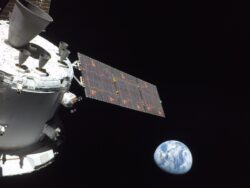A selfie from the Artemis 1 mission showing planet Earth in the background (Credit: Nasa/Twitter)
Nasa’s Artemis spacecraft has successfully arrived at the moon after finally blasting off from Earth last week.
Artemis 1 is carrying the Orion lunar spacecraft which is manned by three test dummies.
Orion’s entry into the lunar sphere of influence will make the moon, instead of Earth, the main gravitational force acting on the spacecraft.
It will be the first time a space capsule has completed a flyby of the moon in half a century.
Jaw-dropping selfies have seen the earth and the moon act as backdrop as the flight control team used cameras on Orion’s solar wings to do a thorough inspection of the spacecraft during its flight.
At 12:44 GMT, flight controllers conducted an outbound powered flyby burn to harness the force from the moon’s gravity, accelerate the spacecraft, and direct it toward a distant retrograde orbit beyond the moon.
During the outbound powered flyby, Orion will make its closest approach to the lunar surface – approximately 80 miles above it.
In four days’ time, another burn using the European Service Module will insert Orion into distant retrograde orbit, where it will remain for about a week to test spacecraft systems.
Howard Hu, the Orion programme manager, said last week’s launch was a ‘historic day for human space flight’.
He told the BBC: ‘It’s the first step we’re taking to long-term deep space exploration, for not just the United States but for the world.
‘I think this is an historic day for Nasa, but it’s also an historic day for all the people who love human space flight and deep space exploration.
‘I mean, we are going back to the moon, we’re working towards a sustainable programme and this is the vehicle that will carry the people that will land us back on the moon again.’
To view this video please enable JavaScript, and consider upgrading to a web
browser that
supports HTML5
video
Named after the Greek goddess of the moon, the Artemis programme will see the construction of the Lunar Gateway – a new space station where astronauts will be able to live and work.
Mr Hu said the gateway would act as an orbiting platform and staging post for lunar missions, with astronauts taking ‘landers’ from the platform to and from the moon.
The space agency is aiming to send four astronauts around the moon on the next flight, in 2024, and land humans there as early as 2025.
The 322-foot (98-meter) Space Launch System (SLS) rocket that made up the Artemis 1 mission is the most powerful ever built by Nasa, with more thrust than either the space shuttle or the mighty Saturn V that carried men to the moon the first time.
Nasa’s most powerful rocket, the SLS, will take humans back to the moon (Credits: AP)
A series of hydrogen fuel leaks plagued the summertime launch attempts as well as countdown tests.
This $4.1 billion test flight is set to last 25 days, roughly the same as when crews will be aboard. The space agency intends to push the spacecraft to its limits and uncover any problems before astronauts strap in.
Nasa’s next-generation moon rocket, the Space Launch System (SLS) rocket with the Orion crew capsule, lifts off from launch complex 39-B on the unmanned Artemis 1 mission to the moon (Credit: Reuters)
The mannequins – Nasa calls them moonequins – are fitted with sensors to measure such things as vibration, acceleration and cosmic radiation.
‘There’s a fair amount of risk with this particular initial flight test,’ said mission manager Mike Sarafin.
Ultimately, Nasa hopes to establish a base on the moon and send astronauts to Mars by the late 2030s or early 2040s.
MORE : Nasa says humans will live on the moon by end of the decade
MORE : Nasa’s James Webb telescope reveals the universe’s earliest galaxies
For the first time in 50 years, a space capsule will fly by the moon.





